-

《弯弯的月亮》教案
教学过程:一、导入:播放克莱德曼的钢琴曲《思乡曲》作为背景,结合图片,创设情境,谈话式导入新课。师:现在同学们听到的这首钢琴曲,旋律优美,略带忧伤,作者想表达什么呢?这首曲子名为《乡愁》,也被译作《思乡曲》。古今中外,思乡之情人皆有之,思乡之作举不胜举,很小的时候,大家都会吟诵“举头望明月,低头思故乡。”月亮仿佛成了思想的代名词,久别家乡的游子,仿佛能从月亮里看到家乡亲人的笑脸,看到自己童年的情景。月儿总是故乡明,无论身在何地,离开故乡的游子都会时刻挂念自己的家乡。今天的音乐课我们就来学唱一首带有思想情绪的歌曲《弯弯的月亮》。思考题:已知单线谱线上的音符唱“re”,你能推算出其他音符的唱名么?跟琴视唱声曲谱。这首短短的曲谱里蕴含着音乐家的思乡之情。老师这里也有一首小曲,一起来听听,请看大屏幕。【设计意图:传统的谈话式导入,借助音乐、画面、语言,创设情境。】二、歌曲教学:1、出示旋律图谱。2、学生在老师钢琴的引导下,用首调视唱曲谱,简单了解一个降号调的演唱,并用lu体会悠扬的思乡之情。3、教师设问:请同学们循环重复演唱这两句旋律,你们在唱的时候,还会听到老师不同的声音,我们来试试看。
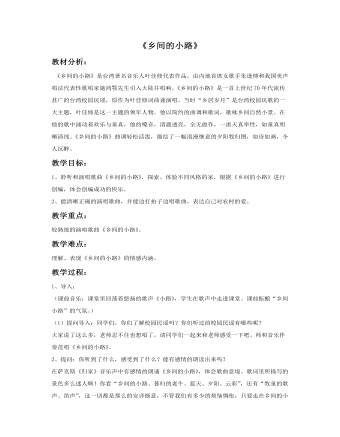
《乡间的小路》教案
教学过程:1、导入:(课前音乐:课堂里回荡着悠扬的歌声《小路》,学生在歌声中走进课堂。课前酝酿“乡间小路”的气氛。)(1)提问导入:同学们,你们了解校园民谣吗?你们听过的校园民谣有哪些呢?大家说了这么多,老师忍不住也想唱了,请同学们一起来和老师感受一下吧。师和音乐伴奏范唱《乡间的小路》。2、提问:你听到了什么,感受到了什么?能有感情的朗读出来吗?在萨克斯《归家》音乐声中有感情的朗诵《乡间的小路》,体会歌曲意境。歌词里所描写的景色多么迷人啊!你看“乡间的小路、暮归的老牛、蓝天、夕阳、云彩”,还有“牧童的歌声、笛声”,这一切都是那么的安详惬意,不管我们有多少的烦恼惆怅,只要走在乡间的小路上,它们都会随风飘散,消失得无影无踪。这么优美如诗、风光如画的歌曲,让我们再聆听一遍,请大家一边视听一边思考:歌曲可以分为几个部分?每个部分给你的情绪感受都是一样的吗?播放歌曲视频。3、新课:(1)欣赏歌曲《乡间的小路》,边听边用脚轻踩拍子,注意重拍。 a、歌曲所表现的内容是什么?情绪如何? b、歌曲的重拍在哪?是几拍子?(第二遍聆听)
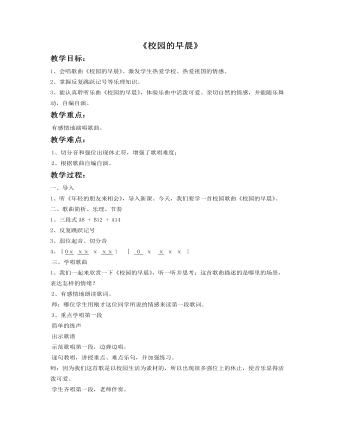
《校园的早晨》教案
教学过程:一、导入1、听《年轻的朋友来相会》,导入新课。今天,我们要学一首校园歌曲《校园的早晨》。二、歌曲简析、乐理、节奏1、三段式A8 + B12 + A142、反复跳跃记号3、弱位起音、切分音4、︱0ⅹ ⅹⅹ ⅹ ⅹⅹ∣ ︴ 0 ⅹ ⅹ ⅹ ⅹ ∣ 三、学唱歌曲1、我们一起来欣赏一下《校园的早晨》,听一听并思考:这首歌曲描述的是哪里的场景,表达怎样的情绪?2、有感情地朗读歌词。师:哪位学生用刚才这位同学所说的情感来读第一段歌词。 3、重点学唱第一段简单的练声出示歌谱示范歌唱第一段,边弹边唱。逐句教唱,讲授重点、难点乐句,并加强练习。师:因为我们这首歌是以校园生活为素材的,所以出现很多强位上的休止,使音乐显得活泼可爱。学生齐唱第一段,老师伴奏。 打节奏要清晰,打的声音不要太大。4、学唱第二段(1)分句指导歌唱(同上)。(2)重点练唱:有强位休止符的乐句;有切分音的乐句。(3)学生齐唱第二段,老师伴奏。5、学唱第三段(1)重点学唱最后一句,齐唱第三段。
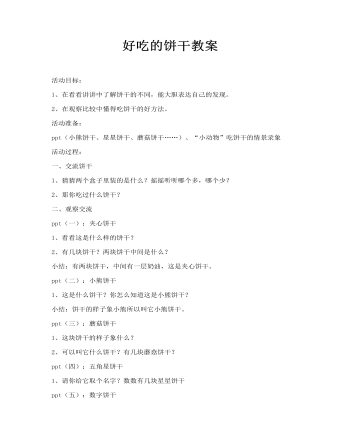
好吃的饼干教案
一、交流饼干1、猜猜两个盒子里装的是什么?摇摇听听哪个多,哪个少?2、那你吃过什么饼干?二、观察交流ppt(一):夹心饼干1、看看这是什么样的饼干?2、有几块饼干?两块饼干中间是什么?小结:有两块饼干,中间有一层奶油,这是夹心饼干。
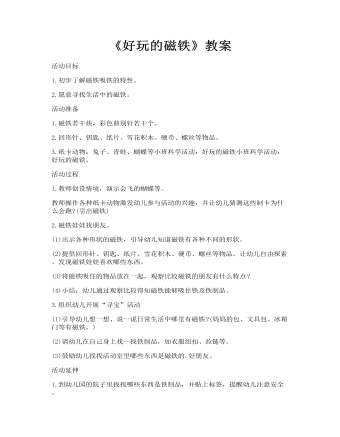
《好玩的磁铁》教案
1.教师创设情境,演示会飞的蝴蝶等。教师操作各种纸卡动物激发幼儿参与活动的兴趣,并让幼儿猜测这些制卡为什么会跑?(引出磁铁)2.磁铁娃娃找朋友。(1)出示各种形状的磁铁,引导幼儿知道磁铁有各种不同的形状。(2)提供回形针、钥匙、纸片、雪花积木、硬币、螺丝等物品,让幼儿自由探索、发现磁铁娃娃喜欢哪些东西。(3)将磁铁吸住的物品放在一起,观察比较磁铁的朋友有什么特点?
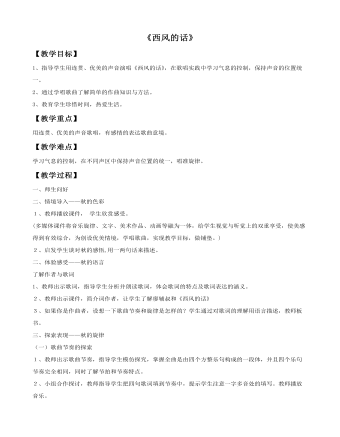
《西风的话》教案
一、师生问好二、情境导入——秋的色彩1、教师播放课件, 学生欣赏感受。(多媒体课件将音乐旋律、文字、美术作品、动画等融为一体,给学生视觉与听觉上的双重享受,使美感得到有效综合,为创设优美情境,学唱歌曲,实现教学目标,做铺垫。) 2、启发学生谈对秋的感悟,用一两句话来描述。 二、体验感受——秋的语言了解作者与歌词1、教师出示歌词,指导学生分析并朗读歌词,体会歌词的特点及歌词表达的涵义。2、教师出示课件,简介词作者,让学生了解廖辅叔和《西风的话》3、如果你是作曲者,设想一下歌曲节奏和旋律是怎样的?学生通过对歌词的理解用语言描述,教师板书。三、探索表现——秋的旋律(一)歌曲节奏的探索1、教师出示歌曲节奏,指导学生模仿探究,掌握全曲是由四个方整乐句构成的一段体,并且四个乐句节奏完全相同,同时了解节拍和节奏特点。2、小组合作探讨,教师指导学生把四句歌词填到节奏中,提示学生注意一字多音处的填写。教师播放音乐。
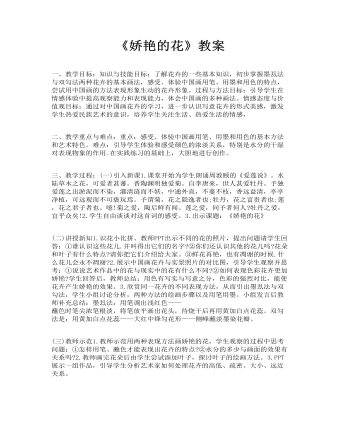
《娇艳的花》教案
二、教学重点与难点:重点:感受、体验中国画用笔、用墨和用色的基本方法和艺术特色。难点:引导学生体验和感受颜色的浓淡关系,特别是水分的干湿对表现物象的作用.在实践练习的基础上,大胆地进行创作。 三、教学过程:(一)引入新课1.课堂开始为学生朗诵周敦颐的《爱莲说》。水陆草木之花,可爱者甚蕃。晋陶渊明独爱菊。自李唐来,世人甚爱牡丹。予独爱莲之出淤泥而不染,濯清涟而不妖,中通外直,不蔓不枝,香远益清,亭亭净植,可远观而不可亵玩焉。予谓菊,花之隐逸者也;牡丹,花之富贵者也;莲,花之君子者也。噫!菊之爱,陶后鲜有闻。莲之爱,同予者何人?牡丹之爱,宜乎众矣!2.学生自由谈谈对这首词的感受。3.出示课题:《娇艳的花》
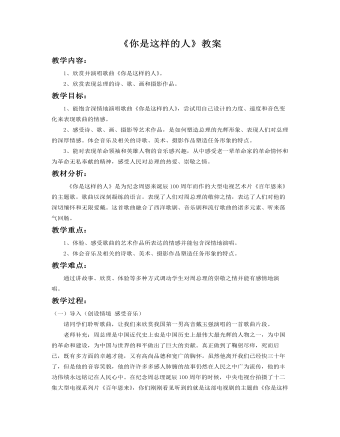
《你是这样的人》教案
教学内容:1、欣赏并演唱歌曲《你是这样的人》。2、欣赏表现总理的诗、歌、画和摄影作品。教学目标:1、能饱含深情地演唱歌曲《你是这样的人》,尝试用自己设计的力度、速度和音色变化来表现歌曲的情感。2、感受诗、歌、画、摄影等艺术作品,是如何塑造总理的光辉形象、表现人们对总理的深厚情感。体会音乐及相关的诗歌、美术、摄影作品塑造任务形象的特点。3、能对表现革命领袖和英雄人物的音乐感兴趣,从中感受老一辈革命家的革命情怀和为革命无私奉献的精神,感受人民对总理的热爱、崇敬之情。教材分析:《你是这样的人》是为纪念周恩来诞辰100周年而作的大型电视艺术片《百年恩来》的主题歌。歌曲以深刻凝练的语言。表现了人们对周总理的敬仰之情,表达了人们对他的深切缅怀和无限爱戴。这首歌曲融合了西洋歌剧、音乐剧和流行歌曲的诸多元素、听来荡气回肠。
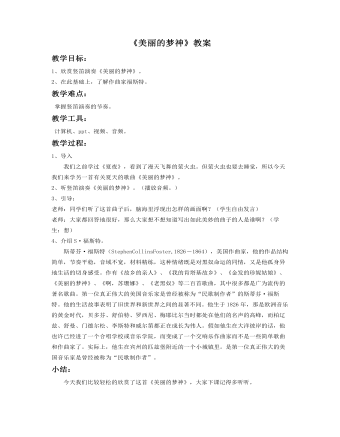
《美丽的梦神》教案
斯蒂芬·福斯特(StephenCollinsFoster,1826-1864),美国作曲家,他的作品结构简单,节奏平稳,音域不宽,材料精练,这种情绪既是对黑奴命运的同情,又是他孤身异地生活的切身感受。作有《故乡的亲人》、《我的肯塔基故乡》、《金发的珍妮姑娘》、《美丽的梦神》、《啊,苏珊娜》、《老黑奴》等二百首歌曲,其中很多都是广为流传的著名歌曲。第一位真正伟大的美国音乐家是曾经被称为“民歌制作者”的斯蒂芬·福斯特。他的生活故事表明了旧世界和新世界之间的显著不同。他生于1826年,那是欧洲音乐的黄金时代,贝多芬、舒伯特、罗西尼、梅耶比尔当时都处在他们的名声的高峰,而柏辽兹、舒曼、门德尔松、李斯特和威尔第都正在成长为伟人。假如他生在大洋彼岸的话,他也许已经进了一个合唱学校或音乐学院,而变成了一个交响乐作曲家而不是一些简单歌曲和作曲家了。实际上,他生在宾州的匹兹堡附近的一个小城镇里。是第一位真正伟大的美国音乐家是曾经被称为“民歌制作者”。
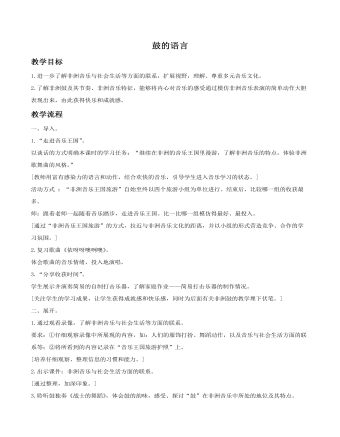
《鼓的语言》教案
展开。1.通过观看录像,了解非洲音乐与社会生活等方面的联系。要求:①仔细观察录像中所展现的内容,如:人们的服饰打扮、舞蹈动作,以及音乐与社会生活方面的联系等;②将所看到的内容记录在“音乐王国旅游护照”上。[培养仔细观察、整理信息的习惯和能力。] 2.出示课件:非洲音乐与社会生活方面的联系。[通过整理,加深印象。] 3.聆听鼓独奏《战士的舞蹈》,体会鼓的韵味,感受、探讨“鼓”在非洲音乐中所处的地位及其特点。[强化视听感受。] 用言简意赅的文字在“非洲音乐王国旅游护照”上记下对演奏乐器的印象和音乐风格特点的感受。听赏《战士的舞蹈》,共享组队(同桌二人组),探讨“鼓”在非洲音乐中所处的地位及其特点。分享、交换意见。[促进思维,加强合作探究。] 小结:鼓在非洲人民生活中的重要地位是任何其他乐器都无法比拟的,这是因为非洲音乐中最突出、最主要的因素是节奏,而鼓是非洲音乐节奏的基础,是表达音乐语言最重要的乐器之一。鼓不仅可以用于音乐,有时还是民族、部落或宗教和象征,甚至还可以传递各种信息。在非洲,不论是制造鼓的材料,还是鼓的形状,或是持鼓方式、演奏方式、演奏技巧等方面,都具有极其浓郁的民族特色。4.聆听西非现代歌舞曲《巴玛亚》(加纳),用言简意赅的文字在“非洲音乐王国旅游护照”上记下歌曲节奏和旋律的特点,以及演唱方式、伴奏和自我感受。[注重建立听觉印象。]

人教版新目标初中英语七年级下册Where is the post office教案2篇
Period 2 (3a----Section B 2c)Preview(Pre-task): Key points: What laAdd another information about their pen pals----their language on the cardnguage does she/he speak?She/He speaks....Does she/he have any brothers and sisters? Does she/he speak English?Preview(Pre-task): Add another information about their pen pals----their language on the cardKey points: What language does she/he speak?She/He speaks....Does she/he have any brothers and sisters? Does she/he speak English?Step 1 Revision1.Revisionand dictation of the new words 2.Revise the drills they learned yesterday.(by pairwork and grammar exercise)Step 2 Leading-inT has a conversation with one student. The conversation is following:---Do you have a pen pal?---Yes, I do.---What's your pen pal's name? ---His/Her name is....---Where is your pen pal from? ---He/She is from...---Where does he/she live? ---He/She lives in....---What language does he/she speak?He/She speaks...Write the new words on the Bb. They are following: EnglishChineseJapaneseFrenchStep 3 LearnLearn the new words with the whole class.Finish 3a with the students3b Pairwork T still does an example with one student Then the Ss practise in pairs. The example is following:--Curry Muray is my pen pal. He is from the United States.---What language does he speak?

人教版新目标初中英语七年级下册Don’t eat in class教案2篇
Don’t fight. =You can’t fight. (板书,教读)教师把这些句子板书在黑板上,并请学生大声整齐地读祈使句和“can’t”句型,并让学生注意两种句型表达形式的不同和转换,“Don’t …=You can’t…”;并对学生说:These are our school rules. (板书,教读) You can’t break the school rules. Don’t break the school rules.(板书,教读)步骤3 :Practicea. T: Now, each of the students is breaking one of these rules.Please finish 1a.学生看图,完成1a的内容,检查答案并大声朗读校规。b. 听录音,完成1b,选出四位学生都违反了哪条校规;听之前,学生要读会英文名。c. 请两位学生朗读1c部分的句型;要求学生两人一组对话表演,SA扮演外校转来新生,SB告知本校校规。(学生可经过讨论,多说出他们想到的校规,不必只限于书上;教师应给予帮助)2) 第二课时(2a~4)步骤1 :warming up of revisionT: What are the rules at your school?学生使用“can”或祈使句表达各条校规;其中老师可引出“eat in the cafeteria outside”的表达。步骤2 :Practicea.T: Christina is an exchange student. She doesn’t know the rules. Let’s listen, what activities they’re talking about?学生听第一遍时,完成2a;第二遍时,完成2b;b. 请学生领读2c部分,看着2a完成的表格,理解2c活动的要求;分成小组针对2a进行问答;

人教版新目标初中英语七年级下册I want to be an actor教案2篇
三、教学建议第一课时:1. Lead in (Vocabulary)A) Before class, teacher should collect some pictures of working places. For example: Bank, TV Station, Restaurant, Police Station, Hospital ...B) In class, show students the pictures (PowerPoint, OHP). Ask students to tell the name of the working places and the name of the jobs.Shop assistant, doctor, actor, reporter, police office, waiter, bank clerk, studentC) Do exercise 1a and 3a.2. Bingo GameAsk groups of students to make up pairs of cards with a job on one and the related workplace on the other. For example, waiter / restaurant, teacher / school, doctor / hospital. Encourage students to use both the job / workplace combinations in the book and the ones that students came up during class discussions. Be sure they have twice as many sets of cards as there are students in the group. They can make two sets of cards for a single job / workplace, if necessary. Then have each group mix up its set of cards and hand their cards out in random order. Each time a student gets a pair of cards that match, he or she can lay these cards down. The goal is to have no cards in your hand at the end.3. Task OneA) Ask students to work in pairs and ask the partner what does he / she want to be in the future.e. g. :What do you / does he / does she want to be?I want to be a.Why?Because it's (adj).B) Vocabulary: Section B, 1a4. Homework 1.2.

人教版新目标初中英语七年级下册It’s raining教案2篇
1 Each group choose one place to describe and what you are doing in it Choose one place, and describe what they are doing 2 Move around the room and give suggestions Talk about it and write it down 3 Ask one to show their works and act it Choose one of each group to make a report 4 Evaluate the best group and the best reporter Choose the best one Homework Ask your friends their ideal place and write about it教学反思:新课程标准中强调学生在课堂中的主体地位,在综合课中他们的主体地位就更加突出。在各个活动中给不同程度的学生不同层次的任务,让各层面的学生都有表现发挥的机会,从而产生对英语的兴趣。使用照片图片多媒体来辅助教学,效果更好。同时让了解其他国家风景,风俗的同学介绍ideal place,增加学生的背景知知识,实现跨学科交流的目的。教案点评:采用任务型教学模式,在各个活动中给不同程度的学生不同层次的任务,让各层面的学生都有表现发挥的机会,从而产生对英语的兴趣。使用照片图片多媒体来辅助教学,效果更好。让了解其他国家风景,风俗的同学介绍ideal place,增加学生的背景知识,实现跨学科交流的目的。

人教版新目标初中英语八年级下册If you go to the party, you’ll have a great time教案2篇
区分宾语从句、定于从句和状语从句宾语从句和状语从句,都叫做主从复合句。宾语从句主要是中考必考的,是初中阶段必掌握的从句,宾语从句主要是掌握三要素,所谓宾语从句,就是宾语在主从复合句当中充当宾语的一个句子,叫做宾语从句。主句的谓语动词是及物动词,后面如果是词或者是短语的话,是简单句,如果是句子的话,肯定是宾语从句。I know that he good at English.就是宾语从句,三要素,一要素是要注意连词,连词一共学了三类连词,一类连词是that口语当中可以省略,就像刚才说的那一句,I hear he is good at English.还有疑问代词、疑问副词,how where when,疑问代词、疑问副词。还有一类连词weather是否的意思,不是状语从句当中的如果,这一定要和如果区分开,这是是否。I don't know if he interested at English。宾语从句要注意if是连词。第二要素是语序,要用陈述举语序。比如说你家有几口人,我们都说How many people are there in you family?但是这是简单句,一旦说成宾语从句,你可以告诉我你家有几口人吗?Could you tell me how many people there are in you family ?

人教版新目标初中英语八年级下册It’s a nice day, isn’t it教案2篇
"Hello! Welcome to English class! Introduce yourself. Meet your new classmates." That's what the teacher says. What do you say? "Oh no!" It can be difficult talking to new people. But it can be fun, and you can make friends. How do you do it? Make small talk. Small talk is polite conversation. "Wang Nan is a great pingpang player, isn't she?" "I'd love to meet her, wouldn't you?" "It's been raining a lot, hasn't it?" Tag questions are a form of polite speech. To make small talk successfully, you should know how to make them. You should also know what topics to talk about. Try to learn this unit carefully. The next time you're in English class, you'll find out. Making small talk's easy, isn't it? (“你好!欢迎你!请做一下自我介绍。认识一下你的新同学。”通常在课上老师会这样说。你会说什么呢?“噢,不!”与陌生人谈话太困难了。但是这也很有意思,并且你还能交到朋友。你该怎么做呢?闲聊。闲聊指得是礼貌的对话。“王楠是一个很棒的乒乓球运动员,不是吗?”“我希望自己能认识她,你呢?“今年的雨水很多,不是吗?”反意疑问句是一种礼貌用语。为了使得谈话成功,你应该知道怎样去进行闲聊。你还应该知道与不同的人该谈论什么样的话题。认真的学习这个单元吧,下次在英语课上,你会发现与大家展开谈话是一件很容易的事情,不信我们来试试。)

人教版新目标初中英语八年级下册He said I was hard-working教案2篇
This activity introduces some new vocabulary and provide oral practice using the target language.Task 1 . Ask four students to stand in front of the class, and the teacher asks them the following questions as a reporter.1.What are you going to do when you grow up?2.What are you going to do next week?3.What are going to do after school?The students will give different answers, then ask a good student to report what they said.I am going to e a doctor.What did she say?----------She said she was going to be a doctor.I am going to have a party on Friday night.What did he say?-------He said he was going to have a party on Friday night.I am going to do my homework.What did she say ?------ She said she was going to do her homework.I am going home after school.What did she say?-----She said she was going home after school.Say In this unit we are going to learn to use words like to report what someone said.Task 2. Read the instructions. Then ask a student to read the four questions. And write the words on the Bb. Explain what soap opera is.Task 3. Ask the students to Look at the pictures, point out the TV screens in the picture. Ask one girl to read what Marcia said.What did Marcia say? She said She said she was having a surprise party for Lana on Friday night. Repeat the other pictures in the same way.Activity3. Listen and number the pictures in activity 1a.

人教版新目标初中英语八年级下册How long have you been collecting shells教案2篇
Step Ⅱ Show the new words on the screen and teach the new words. Read the new words to students and ask them to repeat.Step Ⅲ 3aThis activity introduces new vocabulary and provides reading practice using the target language.In this activity first look at the four pictures.T: What can you see in the pictures?Ss: Four snow globes.T: Right. There are four snow globes in the pictures. And what are they?Ss: They are a monster, two polar bears, two penguins and a birthday cake.Write these words on the blackboard: snow globe; monster; polar bear; penguin and birthday cake. Read them to the class and ask students to repeat each one. Make sure students understand each word.Use a computer to show the E-mail message on the screen and read the message to students.Get students to read the e-mail on their own, and then draw lines connecting each snow globe and its description.Correct the answers.AnswersA line should connect each snow globe picture with the words that describe it in the letter.Step Ⅳ 3bThis activity provides writing practice using the target language.First review Activity 2a on Page 47.Then ask students to complete the message according to Activity 2a.Some partial sentences are given to students. Write about one person's collection.When students work, walk around the room checking the progress and offering help as needed.When they finish, ask some students to read their messages to the class.

人教版新目标初中英语八年级下册What were you doing when the UFO arrived教案2篇
(一).知识方面: 1.培养学生能运用过去进行时来描述、谈论过去某个时间正在发生的事情或动作的意识和能力,能就过去某个时间正在发生的动作做出正确的描述。 2.培养学生的想象力和角色扮演的合作能力。 3.培养学生讲述过去发生的事情经过的能力。能正确运用一般过去时来讲述故事。 (二).技能方面: 1.本单元的语言目标是Talk about past events and tell a story(谈论过去的时间和讲述一个故事),围绕这一目标,要涉及句型: What were you doing when the UFO arrived? ----I was sitting in the barber’s chair. The barber was cutting my hair. 因此必须学习standing、studying、cleaning、sleeping、cooking、making、eating、cutting、等表示地点的词,以便为上述句型提供语言材料。2.学习过去进行时的有关知识。Was/were+现在分词,是该时态的表达式。 3.在学习过程中,要区分The boy was walking down the street when the UFO landed.和While the boy was walking down the street, the UFO landed.这两种由when和while引导的状语从句的句型结构。注意它们的不同。

人教版新目标初中英语七年级下册How was your weekend教案2篇
Teaching Goal:1. General aims:Talk about recent past events2. Particular aims:A. Language Focus.Talk about recent past events and think of the past events.B. Language goalsHow was….?It was …What did …do over the weekend?C. Language structures:(1). How was your weekend? I was great. Pay attention to no form.(2). What did you do over the weekend? I played soccer. We went to the beach.D. Useful words and phrases:Words: was, did, went, beach, over, project, test, wasn’t, false, number, geography, spend, week, most, mixture, their, had, little, cook, read, saw, change, everyone, sit, sat, no, anythingPhrases: did one’s homework, played soccer, cleaned my room, went to the beach, played tennis, went to the movies, on Saturday morning, over the weekend, cook … for, what about, do some reading, have a party, talk show, go shoppingE. Grammar language:Present simple past tenseRegular and irregular verbsF. Learning strategies:Tour and holidaysG. Interdiscipinary:H. Emotion and manner:Teaching time: 5 periodsTeaching procedures:Period One教学步骤、时间 教师活动 学生活动 媒体应用Step 1Free talk 3’ Ask some questions like:Who’s on duty today?What’s the weather like? Answer and talk about something.让同学们回答下列问题1. Do you like weekend? (Let some students answer)It takes them three minutes to talk about the question.2. Why do you like weekend? (let the students answer) Most of the students like the weekend此时教师用汉语问:“在周末期间问你干了什么?这句话用英语这么回答?Let the students guess.At last the teacher give them right answer3. What did you do over the weekend?(板书、学习)

